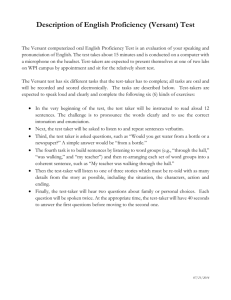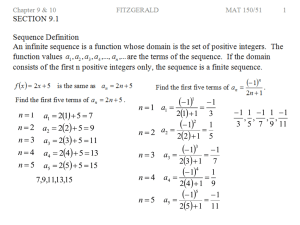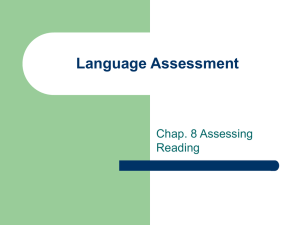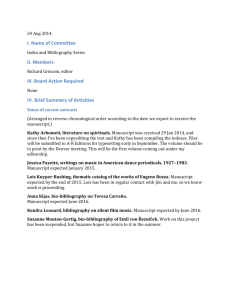Solutions - Mu Alpha Theta
advertisement
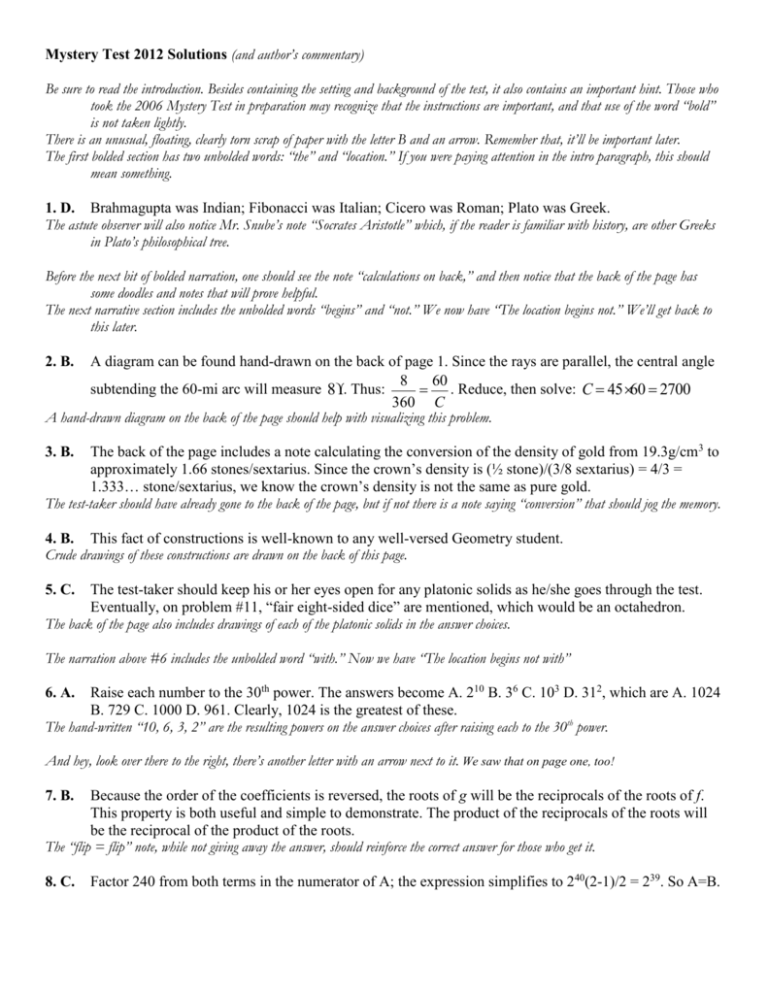
Mystery Test 2012 Solutions (and author’s commentary)
Be sure to read the introduction. Besides containing the setting and background of the test, it also contains an important hint. Those who
took the 2006 Mystery Test in preparation may recognize that the instructions are important, and that use of the word “bold”
is not taken lightly.
There is an unusual, floating, clearly torn scrap of paper with the letter B and an arrow. Remember that, it’ll be important later.
The first bolded section has two unbolded words: “the” and “location.” If you were paying attention in the intro paragraph, this should
mean something.
1. D. Brahmagupta was Indian; Fibonacci was Italian; Cicero was Roman; Plato was Greek.
The astute observer will also notice Mr. Snube’s note “Socrates Aristotle” which, if the reader is familiar with history, are other Greeks
in Plato’s philosophical tree.
Before the next bit of bolded narration, one should see the note “calculations on back,” and then notice that the back of the page has
some doodles and notes that will prove helpful.
The next narrative section includes the unbolded words “begins” and “not.” We now have “The location begins not.” We’ll get back to
this later.
2. B.
A diagram can be found hand-drawn on the back of page 1. Since the rays are parallel, the central angle
8
60
subtending the 60-mi arc will measure 8° . Thus:
= . Reduce, then solve: C = 45× 60 = 2700
360 C
A hand-drawn diagram on the back of the page should help with visualizing this problem.
The back of the page includes a note calculating the conversion of the density of gold from 19.3g/cm3 to
approximately 1.66 stones/sextarius. Since the crown’s density is (½ stone)/(3/8 sextarius) = 4/3 =
1.333… stone/sextarius, we know the crown’s density is not the same as pure gold.
The test-taker should have already gone to the back of the page, but if not there is a note saying “conversion” that should jog the memory.
3. B.
4. B. This fact of constructions is well-known to any well-versed Geometry student.
Crude drawings of these constructions are drawn on the back of this page.
5. C.
The test-taker should keep his or her eyes open for any platonic solids as he/she goes through the test.
Eventually, on problem #11, “fair eight-sided dice” are mentioned, which would be an octahedron.
The back of the page also includes drawings of each of the platonic solids in the answer choices.
The narration above #6 includes the unbolded word “with.” Now we have “The location begins not with”
Raise each number to the 30th power. The answers become A. 210 B. 36 C. 103 D. 312, which are A. 1024
B. 729 C. 1000 D. 961. Clearly, 1024 is the greatest of these.
The hand-written “10, 6, 3, 2” are the resulting powers on the answer choices after raising each to the 30th power.
6. A.
And hey, look over there to the right, there’s another letter with an arrow next to it. We saw that on page one, too!
7. B.
Because the order of the coefficients is reversed, the roots of g will be the reciprocals of the roots of f.
This property is both useful and simple to demonstrate. The product of the reciprocals of the roots will
be the reciprocal of the product of the roots.
The “flip = flip” note, while not giving away the answer, should reinforce the correct answer for those who get it.
8. C.
Factor 240 from both terms in the numerator of A; the expression simplifies to 240(2-1)/2 = 239. So A=B.
9. C.
Since a1 = b1 , let’s just write each of the equations given term in terms of a1, the common ratio r, and
the common difference d:
(1) a1 + d = a1r
Subtract these equations, and you get
(2) a1 + 3d = a1r 2
(3) 2d = a1r 2 - a1r . We’ll come back to this. Now multiply both sides of (1) by r to get
(1*) a1r + dr = a1r 2 . Subtract a1r from both sides to get
(1**) dr = a1r 2 - a1r .
The right-hand sides of (1**) and (3) are equal, so the left-hand sides must be equal. Thus: 2d = dr, and
we discover that r = 2. Since we know b4 = b1r 3 = a1r 3 = 20 , we can substitute 2 for r and solve:
20 5
a1 = 3 = .
2
2
One form of equation (2) was hand-written by Mr. Snube in the margin.
10. C. Because of the gcd constraint, an ordered triple can’t contain both 2 and 4, both 2 and 6, or both 3 and 6.
Two can be included in three ways: (2, 3, 5), (2, 3, 7), (2, 5, 7),
Four can replace two in each of those: (4, 3, 5), (4, 3, 7), (4, 5, 7),
Not including two and four leaves two options: (3, 5, 7), and (5, 6, 7).
The prime factorizations are hand-written next to the problem to help test-takers note which numbers have common divisors.
11. A. The sum can be anything from 2 to 16; The primes in that interval are 2, 3, 5, 7, 11, and 13.
2 can be achieved in one way: 1+1.
3 can be achieved in two ways: 1+2 and 2+1.
5 can be achieved in four ways: 1+4, 2+3, 3+2, 4+1.
7 can be achieved in six ways: 1+6, 2+5, 3+4, 4+3, 5+2, 6+1.
11 can be achieved in six ways: 3+8, 4+7, 5+6, 6+5, 7+4, 8+3.
13 can be achieved in four ways: 5+8, 6+7, 7+6, 8+5.
Thus there are 23 ways to get a prime sum. There are clearly 64 total possible results from rolling the
die, thus the probability of getting a prime sum is 23/64.
The word “eight” is underlined, both to emphasize the fact that these are not normal dice, and to help the reader recall the platonic solids
question, #5.
12. A. No concave polygons can be formed. Cyclic polygons are always convex.
There’s another letter with an arrow next to it in the left-hand margin. What’s up with those things, anyway?
13. D. There are 5C3 = 10 triangles, 5C4 = 5 quadrilaterals, and 5C5 = 1 pentagon that can be formed, for a total
of 16.
14. C. Subtract the half-full glass from the full glass to get that the water in the half-full glass weighs 1/5 – 1/7
= 2/35. Subtract this from the half-full glass to get that an empty glass is 1/7 – 2/35 = 3/35.
15. B. This is known as Fermat’s Last Theorem. If you don’t know the story behind it, you should look it up.
The margin note next to this one is a reference to the note Fermat left in the margin upon posing this question.
16. B. It initially looks like the next term in the sequence should be a downward-facing arrow. This is
reinforced by the location of answer choice C in the left margin between problems 12 and 13. However,
once the test-taker reaches the last page of the test, he or she will notice the rest of the torn bottom of the
page, including two more terms of the sequence from problem 16. This makes it clear the answer should
be an arrow pointing to the left, which is answer choice B, appearing on page 1 of the test.
FINALLY we see what the deal is with those letters and arrows from earlier in the test. The test-taker should be aware that this is not
your normal test, and there may be more tricks to come.
Notice the extra touch of having the same torn bottom as the previous page. It’s the little things that make the difference.
On to page 3: making this page took ages. The folding, spacing, tearing, and scanning had to be re-done every time there was an edit.
The narration at the top of the page has the unbolded word “its.” Now we have “The location begins not with its”.
17. E. The Seven Bridges of Konigsberg is a famous problem solved by Euler and often cited as the beginning
of the field of math called Graph Theory. The land-masses form four points (called nodes) and the
bridges form seven edges connecting them. The solution, from the Wikipedia article on the subject:
Euler observed that (except at the endpoints of the walk), whenever one enters a vertex by a bridge, one leaves the
vertex by a bridge. In other words, during any walk in the graph, the number of times one enters a non-terminal
vertex equals the number of times one leaves it. Now, if every bridge has been traversed exactly once, it follows
that, for each land mass (except possibly for the ones chosen for the start and finish), the number of bridges touching
that land mass must be even (half of them, in the particular traversal, will be traversed "toward" the landmass; the
other half, "away" from it). However, all four of the land masses in the original problem are touched by an odd
number of bridges (one is touched by 5 bridges, and each of the other three is touched by 3). Since, at most, two land
masses can serve as the endpoints of a putative walk, the proposition of a walk traversing each bridge once leads to a
contradiction.
So there is no way to traverse all the bridges exactly once.
The margin note “Need map” should help jog the test-taker’s memory that the back of page 1 had exactly the map we’re looking for.
This will help even more in the next question, when even those familiar with Konigsberg may need to visualize the layout.
18. B. With this change, there are now two nodes touched by an odd number of bridges: each of the islands.
This means both the start and end of the walk must be on an island. (Note: Some may try to dispute this,
saying that it’s impossible to begin a walk on an island, since the walker would have had to previously
cross a bridge in order to be on the island. For this, consider that the “beginning” of a walk could be
measured long after the walker had previously crossed a bridge some time in the past. For example: a
person living on one of the islands could conceivably begin the walk from his home. Every journey
begins somewhere; how you get to the
starting location is irrelevant.)
19. C. After following the folding instructions on
this page (it should be simple, since W, X,
Y, and Z are labeled and the creases are
visible), one should end up with the image
shown to the right. The resulting shape is
shown, with the shape and size of the
original, unfolded page around it as well.
The shape is clearly a rectangle with an
isosceles right triangle cut from one
corner, thus giving the shape 5 sides.
20. E. Once again referencing the diagram to the
right: it is clear that the shape is a 51/8 by
11/2 rectangle with an isosceles right
triangle cut from it. By noting the lines are
at 45-degree angles, the many sets of
parallel lines, and by subtracting the
lengths of overlying folds (important
measurements are labeled on the diagram),
one can find that the isosceles right
triangle’s legs are 7/8. Thus, the total area
is: (51/8)(11/2) – (1/2)(7/8)*7/8) = 4439/128.
There are unusual things going on in these problems: a box around two words in #19, and some strange curves on the post-fold page.
21. B. First we must find out the time it takes to travel down the river to point B. Call that time t. A shortcut
can be gained by taking the motion relative to the manuscript (i.e. treat the water and the manuscript as
stationary, with the shores moving). With this view, it is clear that your boat should take the same time
moving away from the manuscript as it does returning, so t = ¾hr. Thus, relative to the shore (with
b=boat velocity, c=current velocity) we get the system: (b+c)*(3/4) = 8; (b-c)*(3/4) = 2. Add and solve,
to get the current is 4.
Without using the relative motion trick, the problem can still be done algebraically. Let b=boat speed,
c=current speed, t = time required to travel from A to B, and D = the distance from point B to the
manuscript at 2:07 (when the boat turns around). We know:
(1) (b+c)*t = 8
{equation of boat traveling downstream}
(2) (b-c)*(3/4)=2
{equation of boat traveling upstream to meet manuscript}
(3) [(b-c) + c]*(3/4) = D
{equation of manuscript and boat moving toward each other}
(4) D = 8 – c*t
{distance from the manuscript to point B}
Setting (3) and (4) equal and rearranging results in:
(5) ¾b + c*t = 8
Setting (5) and (1) equal results in:
b*t + c*t = ¾b + c*t
which means t = 3/4 hr. Once this is obtained, substitute into (1) giving a system of equations with (2)
that can be solved, giving c = 4.
22. C. Since there are 15 spokes, there must be 360°/15 = 24° between spokes. Since the wheel can only turn
21° at a time, at turn resulting in the wheel being indistinguishable from its original position means the
rotation will be a multiple of both 21 and 24. The LCM(21, 24) = 21*24/gcd(21, 24) = 21*24/3 = 21*8.
Thus, the least number of turns to return the wheel to an indistinguishable position is 8.
The narration at the top of page 4 has the unbolded words “first” and “letter”. Now we have the full sentence “The location begins not
with its first letter”. But what does it MEAN!?
As a side note, the top of the page has a sketch of a cane (referencing the riddle of the Sphinx) and “Euler?” referencing #27’s poem.
23. B. The only way for the compatriot in the rear to know what hat he wears is if he sees 2 white hats,
meaning his own hat must be black. Since he states that he doesn’t know his hat color, then he must not
see two white hats. So he must either see 2 black hats or see 1 black and 1 white.
The middle man hears the man in the rear, and therefore knows that if he (the middle man) sees a white
hat on the man in the front, then he can determine that his own hat must be black. Since he states that he
does not know his own hat color, then the man in front (you) must not be wearing white. Therefore, your
hat must be black.
The margin next to #23 has some visualizations to help with this somewhat well-known riddle.
24. D. Since the urn is randomly chosen, the by putting only white marble(s) in one urn, one can achieve at
least a 50% chance of survival. As for the second urn, which must contain all the black marbles, we
want to put as many white marbles inside as possible to maximize the survival chances in that urn. The
optimum arrangement is putting 1 white marble in the first urn, then putting all the remaining marbles in
1
1 24 37
the second urn. This results in a survival probability: ×1+ ×
=
2
2 50 50
The doodle next tot his one shows to urns, one with a check (indicating it will let you live) and one with a question mark (indicating an
uncertain result). This should reinforce the correct answer if the test-taker figures it out.
25. B. Flip the first ten cards. Let n be the number of upward-facing cards you flipped. Then the second stack
will contain 10-n upward-facing cards, while the first stack will also contain 10-n. Flipping fewer or
more does not guarantee that both stacks have equal number of upward-facing cards.
26. D. At “dawn” (i.e. babyhood) man crawls, hence 4 legs. In “day” (i.e. most of life), man walks on both
legs. At “twilight” (i.e. old age), man has a cane, hence 3 legs. This is a classic riddle of antiquity, posed
by the Sphinx and solved by Oedipus.
Note that the right-hand margin here has part of the bottom of page 2 (the page number is visible). We see answer choices D and E, but
we also see two more arrows! Hey, those two continue the pattern from number 16! That changes the answer!
27. B. The poem’s first two lines should hopefully make it clear that the letter “e” is being referenced. The
third line refers to the fact that the number e has a non-terminating, non-repeating decimal expansion.
The fourth line asks for the units place of e » 2.718.
This poem is an original work by the author of the Mystery Test, and he is quite proud of it.
28. A. The underline by Mr. Snube implies that “in” and “crease” are separate words. Additionally, problems
19 and 20 cause the test-taker to make creases on the page; when looking at the horizontal crease
passing through problem 19, one notices that the crease passes through the phrase “to fold,” which is in
a different font and has been emphasized by Mr. Snube. The answer depends on the wordplay between
“to fold” and “twofold.”
29. D. This problem is also solved through the folding problem, #19. When the folds are made on that page,
some seemingly random lines and curves on the front and back of the page come together to form the
shape of a spade.
30. D. This problem, as you recall, is asking for the location of the headquarters of the secret society. To solve
this, the test-taker should note first the introduction at the beginning of the test, which says, among other
things, “But proceed cautiously: the bold do not often blaze the way to the secret location.” After this
hint, the test-taker should then be perceptive of the fact that in the bold, italicized notes on each page,
certain words are unbolded. (This is also a call-back to the original mystery test in 2006, which used
bolded numbers to encode an answer.) The unbolded words form the phrase “the location begins not
with its first letter.” Looking at the answer choices to the last question, choice A begins with the letter
A; choice B begins with the letter B; choice C begins with the letter C, and choice E begins with the
letter E. Thus, the answer that begins not with its first letter is D, Rome.
We hope you enjoyed the test, and that it brought enough entertainment and intrigue to hold the attention of test-takers of all levels.
Mr. Snube and Mr. E will be retiring after the 2012 convention and may not be seen for a while; they wish you all the best, and thank
this great organization for everything it has given them.
